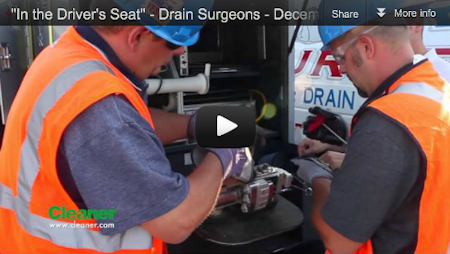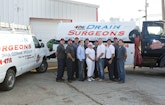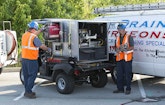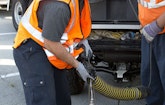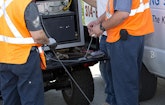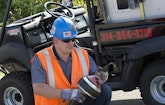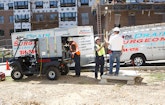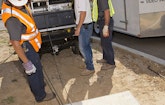Interested in Waterblasting?
Get Waterblasting articles, news and videos right in your inbox! Sign up now.
Waterblasting + Get AlertsBenji Grimes joined Drain Surgeons in Arnold, Mo., with a business degree and experience in construction and real estate development, but he was a beginner in drain cleaning and sewer inspection. His immediate focus became learning all aspects of the industry so he could manage the company his parents, Herman and Connie Grimes, purchased in 2010.
Starting from the bottom up, Grimes worked alongside James Von Klemen, who originally opened Drain Surgeons cleaning grease traps with a single truck. Connie Grimes knew Von Klemen through her company, Grimes Tax, and when he wanted to sell Drain Surgeons, she and her husband saw an opportunity for an investment that would grow with the right leadership.
Von Klemen stayed on as a consultant after selling the company, which by that time had expanded to include five service vans and five employees. In addition to working with Von Klemen, Grimes began riding along with the technicians and learning the trade.
Input and insight
"Since they bought the company we have added some services and equipment," says Benji Grimes. "We now have 13 employees, including my brothers Andrew and Jason Grimes, who handle business administration and dispatching.
"Over time I consulted with the employees as to what they saw within the industry that would benefit Drain Surgeons," he continues, "What equipment would they like to see us acquire? What would make us more versatile, and develop more jobs? Some of the things they suggested included a crawler camera and a combination truck. We were able to include these things, and began to build our portfolio and to see calls from contractors and engineering firms wanting us to come out and help solve their problems.
"It was important for us to get that perspective from our employees who had been around in the industry, who had a career in the business. It made sense for us to get their judgment as to what would be right for our company."
The customer base is now 70 percent commercial, industrial and municipal, and 30 percent in residential sewer and drain cleaning, with all related services. They travel throughout the St. Louis area and into southern Illinois, but will go wherever the job requires.
Grimes says preventive maintenance is something they stress with their clients, since homeowners do not want to have their basements flooded because of a stoppage, and factory owners don't want to pay thousands of dollars to shut down for a cleanup after a flood.
"Preventive maintenance is the answer," Grimes says. "We have a lot of old clay pipelines, and big trees, and a lot of root infiltration. We have the blockages, and it's just more cost effective when you consider what it would cost to dig-and-replace. People can spend $130 a year for their home lines to be cleaned. The commercial customer can spend $400 to $500 a year to keep the lines clear of roots. We keep a database for our clients, and when it's time to clear a line we give them a call. Our guys go out. We clean it out. They are happy as can be. But here in our area, there will always be roots to clean out. Roots in the mainline, and roots in the laterals."
Preventive maintenance programs usually center on a once-a-year clean-out, but if history shows a more aggressive root problem, they might put the customer on a six-month schedule.
Drain Surgeons has worked for several municipalities in their service region. Grimes says some municipalities are making changes to their drain cleaning and inspection programs and are outsourcing more and more of their preventive maintenance work.
"It all depends on their budgets, their equipment and staff," he says. "Some municipalities bought big sewer equipment and hired staff to operate it, but the budgets keep creeping up. It's costing more to keep the equipment and to staff those vehicles. They save money in the long run by bringing in an outside company."
Another important client base for Drain Surgeons is in the community of universities and colleges. Drain Surgeons has worked on the campus of Washington University in St. Louis, as well as Missouri Baptist University, Saint Louis University, Webster University and others in the greater St. Louis area.
Some of these campuses are large, with older clay pipes that are prone to breaks in the joints caused by shifting ground. Roots get in and grow bigger and bigger, and eventually close off the entire line if not kept clear. New construction typically utilizes PVC pipe that eliminates most issues unless there is a collapse or a big piece of debris that has to be located and removed.
On the road
The Drain Surgeons service fleet includes seven Ford E-250 extended vans, from 2003 to 2011. Grimes estimates that each service van carries close to $50,000 in equipment and supplies.
In lieu of a CCTV van, Drain Surgeons uses a Kawasaki Mule 4x4, which is transported in a Cargo South trailer behind a service van, providing easier access to difficult locations. An Envirosight ROVVER 125 camera with pan, tilt and zoom capability serves as the eyes of the unit. With the addition of the crawler camera, technicians can now take advantage of 600 feet of line, as opposed to a push camera with just 100 feet.
Grimes' team also uses Electric Eel eCam Pro and Ratech Electronics Elite Jr. cameras. Locating work is handled with a Radiodetection RD4000 and a RIDGID SeekTech SR-20.
The company's 2002 Hi-Vac B-10 combo truck was acquired from a municipality in Colorado. It has a 2,000-gallon plastic water tank and a 10-yard debris tank, and the O'Brien (Hi-Vac Corp) pump provides 2,200 psi/65 gpm.
Grimes says the Hi-Vac allows them to clean and remove debris at the same time, rather than having a pump truck and a trailer jetter on the job. Another advantage of the B-10 is that the rodding reel is at the rear of the vehicle.
"When the reel is on the front of the truck, there is a hazard for the workers due to the high decibel levels, which can damage the hearing of the operator," he says.
Three trailer jetters include an FMC/John Bean Sewer Jetter producing 1,250 psi/35 gpm with a 300-gallon tank, an O'Brien 3510-E producing 2,500 psi/10 gpm and an O'Brien 2513-JE at 3,000 psi/4.8 gpm. They also have four Electric Eel portable jetters ranging from 1,500 psi/2 gpm to 3,000 psi/4.7 gpm. Grimes says the trailer jetters have been a plus for the company because they are more efficient and effective when cleaning larger lines.
Getting the best for the money
Drain Surgeons uses nozzles from Shamrock Pipe Tools and StoneAge, but Grimes says there's more to selecting a jetter nozzle than the gpm and psi rating. He looks at the warranty offered by the manufacturer. "I want to know if they stand behind the product. If we spend a couple thousand dollars on a nozzle, we want it to last. We want to know they have a warranty that will back up their product."
According to Grimes, paying more doesn't necessarily mean a better nozzle, but a nozzle with a good warranty catches his attention. Of course, matching the right nozzle to the job is also critical.
"An operator using a nozzle needs to know what he is doing," says Grimes. "The nozzle has to be rated with the correct psi and gpm for the flusher, or you won't get the proper performance and you can harm the pump and it could be costly to repair."
Grimes says using the proper nozzle with the jetter is like putting the right size tires on your car. Everything has to work together. They prefer Tier 3 nozzles, but also use Tier 2.
He says the network of contractors in the St. Louis area shares insight on equipment, and if someone has a bad experience, they typically share that information. On the other hand, if a contractor finds a great nozzle or other piece of equipment, that information is shared as well.
"We all talk," says Grimes. "There is plenty of work out there. It's not like, 'Oh my gosh, I'm in a bunker and no one can talk to me.' No. We have an open rapport."
On site and in the field
Drain Surgeons operates out of a 3 1/2-acre site, with an acre for parking and a 2,500-square-foot building for office and warehouse space.
Grimes says his first duty at the beginning of every day is checking the maintenance board to see what needs to be addressed.
"If there are any maintenance jobs, I want to know about it and have that attended to," he says, adding that he and Von Klemen perform most maintenance duties in their own shop. "If a call should come in that requires that equipment and we're not ready to go, I may lose the job. So having equipment up and running, that is my first priority."
Another priority is making sure he has knowledgeable and skilled technicians in the field using the equipment to its full potential and taking good care of customers.
"You are only as strong as your technicians are good at their job," he says. "There are not a lot of sewer cleaners out there, and it takes a special person to do this job."
